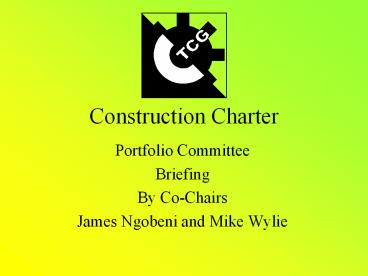Construction Charter - PowerPoint PPT Presentation
Title:
Construction Charter
Description:
Title: Construction Charter Author: Pierre Last modified by: User Created Date: 2/9/2005 9:02:37 AM Document presentation format: On-screen Show Company – PowerPoint PPT presentation
Number of Views:91
Avg rating:3.0/5.0
Title: Construction Charter
1
Construction Charter
- Portfolio Committee
- Briefing
- By Co-Chairs
- James Ngobeni and Mike Wylie
2
BACKGROUND
- Despite progress since 1994 S.A.still face
economic inequalities - The constitution of R.S.A underlines the
importance of redressing inequalities - Government introduced various pieces of
legislation - The Broad Based Black Economic Empowerment Act 53
(2003) provides cohesions and guidance for the
gazetting of Transformation Charters
3
STATUS QUO
- Business, Labour and Government embarked on a
process during 2004 - Objectives
- Define scope
- Ensure participation of
- National Business Organisations including Women
- Labour unions
- Government Department
- Create Integrated Management Committee and other
committees to facilitate participation
4
STATUS QUO
- Business
- ASAQS (The Association of South African Quantity
Surveyors) - ABA (African Builders Association)
- MBSA (Master Builders South Africa)
- NABCAT (National Association of Black Contractors
and Allied Trades) - NAFBI (National Federation for the Building
Industry) - SAACE (The South African Association of
Consulting Engineers) - SABTACO (South African Black Technical and Allied
Careers Organisation) - SAFCEC (South African Federation of Civil
Engineering Contractors) - SAIA (South African Institute of Architects)
- SAISC (South African Institute of Steel
Construction) - SAWIC (South African Women in Construction)
- Women for Housing
- Labour
- NUM
- BCAWU
- Government
- National Department of Public Works (Leading
Department)
5
INTEGRATED MANAGEMENT COMMITTEE
SECRETARIAT
TECHNICAL TEAMS
COMMUNICATIONS COMMITTEE
DRAFTING TEAM
BUSINESS CAUCUS
LABOUR CAUCUS
GOVERNMENT CAUCUS
STAKEHOLDER FORUM
LABOUR
BUSINESS
GOVERNMENT
6
Charter
7
Overview and Challenges
- The industry is skewed in terms of race and
gender - Over the past two decades the sector experienced
declining investment and demand volatility. The
prospect of increased investment goes hand in
hand with increasing capacity and output. - There is a depleted skills base partly due to the
sectors lack of appeal and factors such as
workplace training, mentorship and recognition of
prior learning will need urgent attention. - There is insufficient penetration and lack of
sustainable growth of black companies. - Preferential procurement policies is being
applied on a subjective basis leading to legal
uncertainty. - The industry is fragmented.
8
Objectives of the Charter
- Transformation, growth, competitiveness and
efficiency - Enhance entrepreneurial development and
sustainable growth of BEE companies through
strategic partnerships. - Address skills development with a particular
focus on women. - Achieve a substantial change in the racial and
gender composition of ownership, control and
management. - Bring to an end the malpractice of fronting.
- Lay the foundation for the integration of the
construction sector to provide a single access
point.
9
Application and Reporting
- Charter is applicable to all companies involved
in the creation and/or maintenance of fixed
assets related to residential or non-residential
buildings, infrastructure, or any form of
construction works in South Africa. - Annual reporting/auditing will be promoted.
- Once in operation the charter will be reviewed
periodically. - The charter will take into account the size and
nature of participants. - There will be an oversight structure to implement
and monitor.
10
STEPS TO FIN
- Complete the template which defines the
indicators of the elements of the scorecard.
This work is virtually complete and shown on the
following slides. - Populate the indicators with the relevant
information on the existing situation in the
industry. This info is available from a very
thorough situational analysis which has been
completed over the past 18 months in conjunction
with CETA. We anticipate that this will be
competed by the end of this week. - Finally the weightings and targets. There are
discrepancies between industry, government and
labour and compromises will be sought through a
thorough discussion of the facts. We are hoping
to complete this process by the end of June. - The qualitative part of the charter is complete
and when the quantitative side (scorecard) is
complete our work will be done.
11
SCORECARD TEMPLATE
12
Ownership
13
Control
14
Employment Equity
15
Skills Development
16
Preferential Procurement
Total score of 100 and above
Total score of 80 and above
Total score of 65 to 79.9 or small and micro
enterprises
Total score of 55 to 64.9
Total score of 40 to 44.9 Total score of 20
to 39.9
17
Enterprise Development
18
Residual
19
Regulation and Scorecard
- A scorecard will be implemented to measure
progress in broad based black economic
empowerment. - The charter and scorecard will be issued as a
Code of Good Practice according to which
companies will be evaluated when tendering for
work. - This charter and scorecard will be finalised in
accordance with the requirements of the Codes on
Charter issued by DTI.
20
WAY FORWARD CLOSURE
21
Thank You
- For further information
- CTCG Secretariat 011-455 1700
- www.ctcg.co.za































